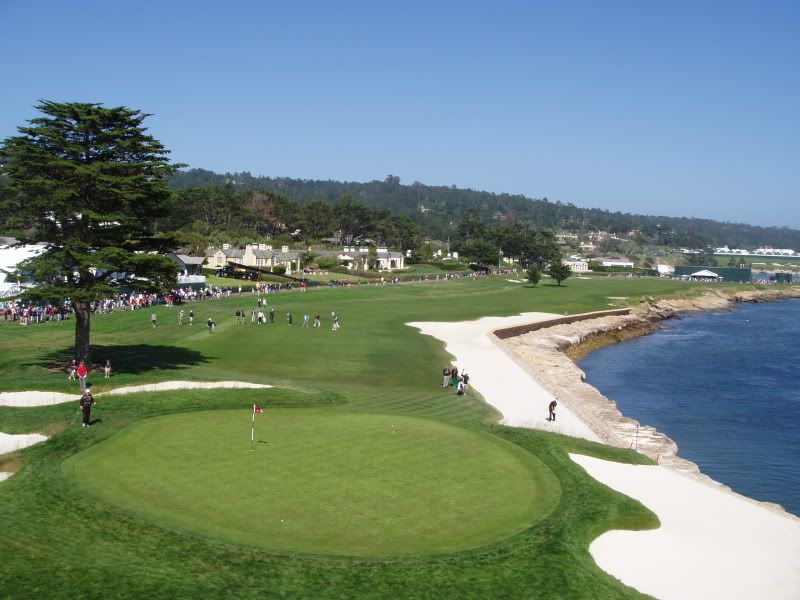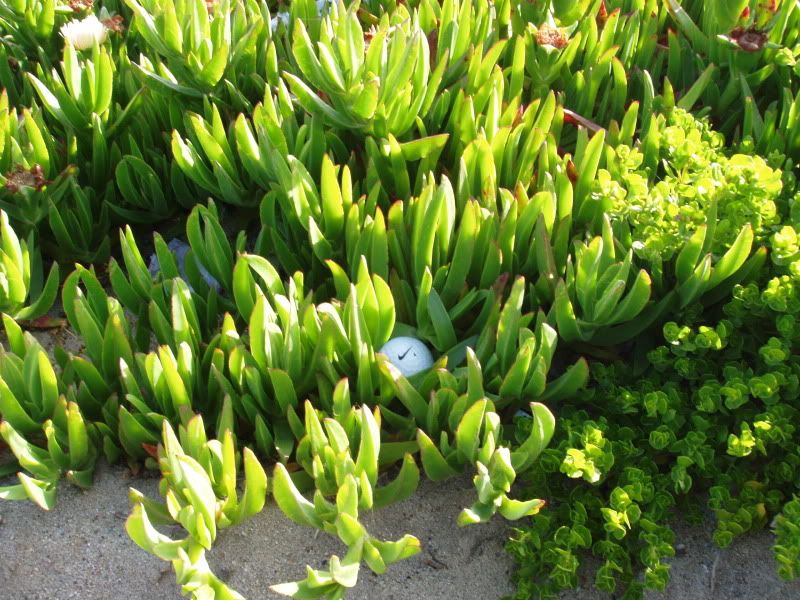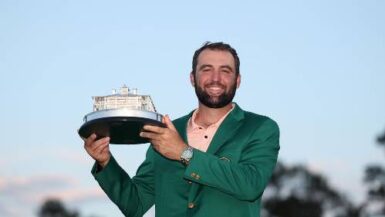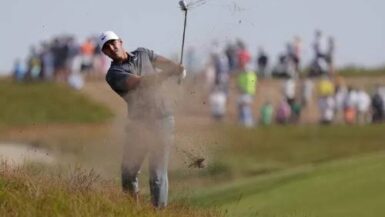
PEBBLE BEACH, CA – In 2000, when Tiger Woods Years lapped the field, broke or tied nearly every important U.S. Open record, and turned our beloved Pebble Beach into flotsam and jetsam in the wake of a yacht insultingly called Privacy, some pundits mistakenly thought Pebble Beach had become obsolete.
Those same pundits ignored the rest of scoreboard. 3-over tied for second, which means no one else in the 154-man field of the world’s greatest golfers broke par. That must be some new definition of “obsolete” with which this author is not acquainted.
Ten years later and, with the benefit hindsight and a more realistic, perhaps even cynical eye towards Woods, we now regard his effort as a statistical outlier. “If he wins again by 15 shots, there ought to be an inquiry,” loosely quipped runner-up Ernie Els, who spent championship Sunday as a marker for Woods’s coronation.
Woods also caught the bluebird weather that week. He didn’t have to face the snarling winds that befuddled the other half of the draw, making challenges fall away like leaves. Then he was able to attack a rain-softened course. “It was an asterisk,” explained Stew Cink, when he commented about how the weather affected the chances of the field.
More than any other U.S. Open course, Pebble Beach will rely on the wind and fast, firm conditions to suppress scoring. Because of it’s cunning routing – the sequencing of the holes and their length and set-up – and because of its tiny, curvaceous greens and side-hill lies, Pebble is still a stern challenge. Moreover, calm weather is anticipated this year: neither rain, nor gale-force winds, so fast, firm conditions will make it tough to stop the ball in the fairways and on the greens.
“Even though it’s the shortest U.S. Open we play, it’s still getting awfully quick out there,” cautioned Woods, who was civil and obliging with golf questions, surly, rude, and more obnoxious than a vuvuzela with anyone who asked about his recovery from scandal. “If they don’t put any water on these things come Sunday it’s going to be very interesting,” he finished.
Additionally, V-grooves will also place the premium once again on shotmaking, not the vilified “bomb-and-gouge” golf that blighted the PGA Tour landscape at many tour stops. Players will have to shape shots from side-hill lies to tiny greens encircled by the worst rough on the course, five inches deep in places.
So instead of the long, relentless grind of an Oakmont, Oakland Hills, or Winged Foot, the mercurial routing of Pebble Beach’s short and long holes will provide fireworks with lots of birdies and bogeys than we are accustomed to at the National Open.
“I buy into the philosophy of making the hard holes harder and the easy holes easier,” explained Phil Mickelson. “I want to see birdies and I want to see bogeys and be challenged on the hard holes and have an opportunity to get a shot back on the easy ones.”
“With the size of the greens out here, anytime you hit a green out here you have a birdie opportunity,” agreed three-time major champion Padraig Harrington. “At the end of the day, compared to other U.S. Opens, it’s not like, you know, hitting at the middle of the green at an event, you’re going to make a par. You hit it in the middle of the green at a Pebble Beach green, you’re probably only going to be 20 feet from the hole. The greens are small and limited where the pins can be.
So I think you’ll see more birdies this week.”
Well, Phil and Paddy, you’re going to get your wish. Happily, so will golf fans.
Pebble Beach Golf Links: Par-71, 7,040 yards.
Hole 1 – Par-4, 380 yards
“Some of them are really narrow, like No. 16 and No. 1. But, I mean, those are holes are pretty short. The longer holes they’ve given us more room to hit the ball into,” said Ernie Els, and he’s right. The shorter holes at Pebble will be made sexier by more danger. This short hole bends gently to the right, but two bunkers guard the left side and a stand of trees guard the right. Still, it’s a good birdie opportunity to start the day.
Birdie op? Green Light
Hole 2 – Par-4, 502 yards
Normally playing as a reachable par-5, a new tee added 18 yards, and a new fairway bunker left turns the fairway into a wasp-waisted shape more reminiscent of Oakland Hills than Pebble Beach. Moreover, someone who knows much more about playing golf than designing a golf course planted “tree gates” in front of the barranca cross hazard, requiring the player to kick a field goal with his golf ball to reach the green. Happily, these changes were not the USGA’s idea, and while an abomination, they are the only negative changes to the course, excepting, of course, the two similar trees at 18. Oh well, we can always pray for lightning.
Birdie op? Red Light
Hole 3 – Par-4, 404 yards
A stand of Cypress planted in 2007 frames the left side corner of this short dog-leg left. The hole highlights a great and under-appreciated defense in golf: alternate shot requirements. While a draw is needed off the tee, a fade is the optimum approach into the green, especially for the new back right hole locations created by a recent expansion of the green.
Birdie op? Green Light
Hole 4 – Par-4, 331 yards
We see the USGA’s new theory for the first time, as the fairway has been shifted back towards the ocean, as Neville meant it when he laid out the course in 1919. “If you leak the ball, there’s no stopping it going over the edge,” lamented Els. The landing area was tightened significantly by new bunkers which, sadly, may have taken driver and a shot at eagle out of too many players’ hands. The green is encircled by sand and has a slightly “pushed-up” style a la A.W. Tillinghast, to further defend against being driven.
Birdie op? Sadly, this once fun green light is now a yellow caution.
Hole 5 – Par-3, 195 yards
The main defense here is wind, but in fairness, even a tough architecture critic like Geoff Shackelford believes the new Jack Nicklaus hole has aged well.
Birdie op? If the wind is down, green light. If not, yellow.
Hole 6 – Par-5, 523 yards
“I don’t think 6 is going to be like they hoped. In moving the green over to the ocean, I don’t think that will play the way they wanted,” stated a candid Phil Mickelson. “I’ve hit 4-iron off the tee every day and I will hit it every day off that tee box, and I can still reach it, I hit 2-iron over the green…I think it’s still a very reachable, very playable par-5.”
Nevertheless, a few angry golfers who drive over the cliff to the beach 75-feet below might disagree. Five new bunkers, each deeper than the last, guard the left side, so forget about bailing out.
Birdie op? Green Light.
Hole 7 – Par-3, 109 yards
Quick! What’s the shortest hole in U.S. Open history? Wrong! It’s number 10 at Inwood C.C., at a paltry 99 yards and no wind. This hole is all about the wind. Is it a wedge or a punch 6-iron today? Hit the green and you’ll have a reasonable putt.
Birdie op? Yellow light
Hole 8 – Par-4, 428 yards
It’s one of the most iconic holes in golf, the fairway hugging the “Cliffs of Doom,” and the green perched on the craggy clifftop. But here again, the beauty belies the difficulty. “8-9-10 are perhaps the toughest stretch in major championship golf,” wrote Herbert Warren Wind back in 1983.
Birdie op? Yellow Light
Hole 9 – Par-4, 505 yards
A new tee adds 40 yards, and reconfigured bunkers on the left and fairway on the right bring the cliffs into play again. The left side features some of the most pronounced side-hill lies on the course, while he green slopes severely left to right, towards the water. “It’s going to be tough stopping the ball on that green,” cautioned Steve Stricker. “The same thing is true of 12, it’s downhill to a shallow green and it’ll be tough to stop the ball.”
Birdie op? Red Light.
Hole 10 – Par-4, 495 yards
This time a new tee adds 50 yards to the hole and, again, the fairway slopes towards the water.
Birdie op? Red Light
Hole 11 – Par-4, 390 yards
Players can’t breathe easier as they turn towards the Del Monte forest. The rumpled fairway offers uneven lies and the tiny, oval-shaped green. Still, it’s the easiest par-4 left on the course.
Birdie op? Green-yellow light
Hole 12 – Par-3, 202 yards
Virtually unchanged since 2000, the shallow green is tough to hit coming downhill with a long-to-mid iron.
Birdie op? Yellow light
Hole 13 – Par-4, 445 yards
A new tee stretches the hole an additional 46 yards, through a chute of trees to a fairway sloping severely from right-to-left. The approach is uphill to the most canted green on the course and is often underestimated by the pros. Shaved chipping areas around the green will make recovery shits dicey. Watch for a few double bogeys here.
Birdie op? Yellow light
Hole 14 – Par-5, 580 yards
A true three-shot hole, three unnecessary fairway bunkers and a Cypress tree were added in a false search for “framing” and “pinching” by Palmer and the other resort owners. The green has a raised back shelf, effectively making it two small greens in one. A cavernous front bunker with a raised lip guards the left side of the green.
Birdie op? Yellow light
Hole 15 – Par-4, 397 yards
Five new bunkers guard the left side of the fairway. One of them intrudes into the fairway, making the tee shot more of an exercise in hitting a target rather than a strategic assessment. Players will club down and still have a high-lofted club in their hands. The bumpy poa annua green has a tendency to break more towards the ocean than it’s counterparts elsewhere on the course.
Birdie op? Green-yellow light.
Hole 16 – Par-4, 403 yards
With Sandy Tatum’s bunker on the right and another Cypress-framed barranca in front of the green, this hole may not be as pretty as the finishers, but is more deadly. It nearly cost Tom Watson the 1982 U.S. Open. “That’s what that bunker was intended to do,” grumbled Tatum after Watson nearly left the ’82 Open in it.
Birdie op? Yellow-red light
Hole 17 – Par-3, 208 yards
Just hit it and hope at this par-3 where the green is shaped like a figure-8 on its side. Theirs is no place to hide as the bunkers are deep, small and feature awkward lies. Maybe the best play is to hit for the front apron and two-putt, like Billy Casper did at Winged Foot in 1959, when he won with a mere 114 putts. “If you couldn’t putt, you’d be selling hot dogs out here,” snarled Ben Hogan after Casper stole that Open with his putter.
Hole 18 – Par-5, 543 yards.
“Technology has made this hole more interesting as more players try for it in two,” wrote architecture expert Ran Morrissett, and he’s right. Now there maybe a chance for an eagle to end the player’s day and send the fans home with a thunderclap.





